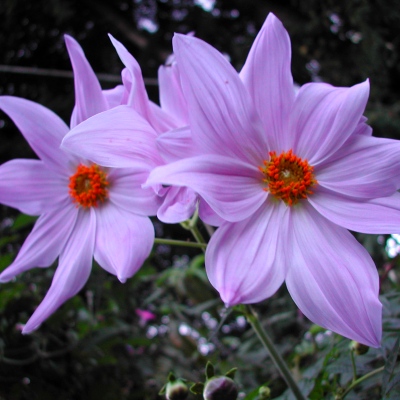Tree Dahlia Dahlia imperialis
Pot size -- I recommend growing your Tree Dahlia in a 1-2 gallon (4-8 liter) pot for the first 6-8 weeks, so you can slowly move it from shade to sun over a period of a few weeks (starting it in sun may burn it). After 2 months, you may transfer it to a larger pot or into the ground. Soil -- Tree Dahlia likes soil that is rich but well-draining. An example would be a mix of 2 parts potting soil to 1 part perlite or coarse sand. It is fairly tolerant of a variety of soils, but avoid extremes like hard clay or pure sand. After repotting -- The first week, give your plant filtered sun or bright shade, and no fertilizer. Then give it about an hour of direct sun, shading it from strong afternoon sun. A week later, move it into an extra hour of sun, and repeat this process each week. This will give your plant time to grow a larger root system, so it can handle more light. If your plant should wilt during this transition period, simply move it into more shade for a week or 2. Planting out -- After 2 months of being in its pot, it may be planted in the ground in suitable climates. If you keep it in a container, a 5 gallon (20 liter) pot should hold it the first year, and a 15 gallon (60 liter) pot the second year. Climate -- Mature plants like full sun, or anything down to a half-day of sun. In hot climates, some afternoon shade might be appreciated. The young shoots and flower sprays are fairly brittle, so protect them from strong winds, or stake them in windy areas. Watering -- For the first few months, aim to keep the soil evenly moist at all times (but not soggy). As the plant's root system gets larger, it can get by with drier soil, but avoid letting it dry out completely. If the leaves start wilting, water it. Fertilizing -- If your potting mix contains fertilizer, your plant shouldn't need feeding the first 2-3 weeks. Then feed about every 2 months during the growing season with a general-purpose fertilizer. It's normal for some of the older leaves to occasionally turn yellow and then brown, but if it seems excessive, it could be from not enough fertilizer (particularly nitrogen), or not enough water. In autumn, around September-October, stop feeding it, or switch to a fertilizer for flowering-plants (with lower nitrogen). Pruning -- If for some reason you don't want a monster-sized plant, or you want to encourage side branches & bushiness, simply prune the tops occasionally during the growing season. Flowering -- The plant flowers late in the year, around late November or early December, so frost may destroy the flowers, depending on where you live. Dormancy -- After flowering, around January, the plants often drop some or all of their branches. You may cut the branches to the ground after flowering if you wish, or leave them. The tubers are said to be hardy to 20-25 degrees F (-7 to -4°C) if well-mulched. Or just dig the tubers up and move them indoors until about April or May. Bugs to watch for -- Spider mites (tiny "dots" under the leaves), Aphids (green ones are hard to see), leaf-miners, snails/slugs. Enjoy your plant! - Jeff Strange Wonderful Things
|
|||||||||


